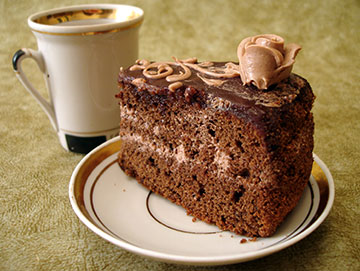Kitchen Tested Tips For Healthy Baked Goods
 Taking the killer out of your aunt's "killer chocolate cake" can be tough, but it can be done. One good place to start is by assessing the health threat. Using one of many free recipe sites that calculate nutrition information can be a big help in this endeavor. Put in the original recipe and see just how many calories and how much fat you are dealing with. This same tool will also help you "what-if" prospective changes.
Taking the killer out of your aunt's "killer chocolate cake" can be tough, but it can be done. One good place to start is by assessing the health threat. Using one of many free recipe sites that calculate nutrition information can be a big help in this endeavor. Put in the original recipe and see just how many calories and how much fat you are dealing with. This same tool will also help you "what-if" prospective changes.
While the biggest calorie savings will likely come from clever use of substitutes, it is important to make sure you are working with the healthiest version of an unhealthy recipe before starting. The measurements in many traditional recipes have more to do with the convenience of the cook than the calorie content.
Some of these are easy to spot. If your cake recipe calls for "a stick of butter", it is a good bet that the amount was somewhat arbitrary. That stick of butter will account for about 800 calories in the resulting mix. By cutting just two tablespoons you can slice off 200 calories from the cake - usually with no noticeable flavor impact.
Sugar is the same way. Before you reach for the substitutes consider simply reducing the amount. If your recipe calls for a cup, cutting out 1/4 of the sugar will knock out nearly 200 additional calories. Assuming eight servings and the butter buster, you have taken 50 empty calories out of every piece. Only after you have gotten rid of fat and sugar that shouldn't have been in the recipe to start with is it time to move on to substitutions.
No substitution cupboard should be without applesauce. The mild flavor of no-sugar added applesauce is a must, and you can substitute it in equal amounts for butter, margarine, oil or shortening in your baking recipes. If you don't bake frequently, consider the individual snack containers. Often times these pre-measured cups are the perfect size for recipes and will keep much longer than an opened jar of applesauce.
These small snack size containers are also available in fruity flavors. Since fat helps carry flavor, using a flavored applesauce that compliments your recipe can be a big help. You can easily find no-sugar added applesauce in strawberry, blueberry or mixed berry flavors. These work great in muffins and cakes of the same flavor. In chocolate recipes, prune puree will often compliment the flavor better than applesauce.
Experimentation is a must, but in general you can safely replace about half the oil in a recipe for applesauce or other fruit puree. For the other half, consider swapping traditional vegetable oil for one of the many "heart healthy" oils on the market that offer lower saturated fat content.
When it comes time to add the eggs, the half replacement rule works well here also. Eggs are an important binding ingredient and dispensing with them entirely is seldom a good solution. For every two eggs a recipe calls for, try 1 whole egg and 1/4 of a cup of egg whites.
Sugar substitutes can get a little sticky. Sugar helps hold moisture in a way that artificial alternatives can't match. Your sugar choice can also compliment or hinder your other substitution selections. Since you have already cut the sugar as much as possible, consider using a different type of sugar rather than replacing it all together.
Many recipes that do not call for brown sugar can benefit from it. While there is no real calorie benefit in swapping white sugar for brown, you do gain a taste advantage. The richer taste of brown sugar can help offset the flavor loss from the fat reduction. Honey can also be useful, but will require a good amount of experimentation to get the amount right. If you do opt for a sugar alternative, use one designed for baking that measures like sugar and try cutting just a 1/4 of a cup at a time.
There are just two more baking staples we need to alter: vanilla and chocolate. When reducing the fat and sugar, using dutch processed cacao powder will help keep flavor intact. Processed with alkali, it is slightly less bitter than traditional cacao and as result, tends to be easier to sweeten. You will also want to use real vanilla extract and add about 50% more than the original recipe specifies. Vanilla's subtle flavor is critical to many baked goods, and with less fat to carry it, you will need the extra.
When it comes time to bake your lower calorie creation, you will need to carefully monitor cook times, since they are sometimes altered by as much as 30 or 40 percent. Not only will it cook faster, the lower calorie version will not hold moisture as well and a little over baking can result in a lot of damage.
These guidelines should help you get started, but don't be afraid to experiment and trust your instincts. After a few experiments, you will gain a feel for what alterations are likely to succeed.
Diet Plan Coupons
- Nutrisytem
- Medifast
- Diet to Go
- Weight Watchers
- Jillian Michaels
- South Beach Diet
- Cookie Diet
- Duke Diet
- Bob Greene BestLife
- eDiets
- Sonoma Diet
- Denise Austin
- Biggest Loser Club
